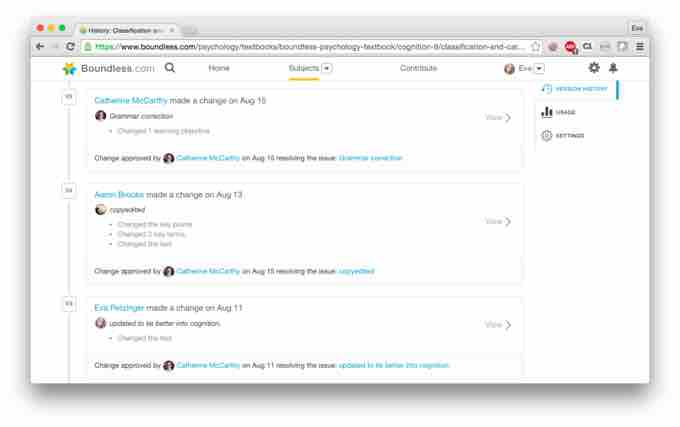At Boundless, we strongly believe in promoting open educational resources, or OER, to help open up access to higher education. Many schools across the country have also begun to push initiatives encouraging professors to use OER in their classes in an effort to reduce textbook costs for their students.
The enormous amount of available OER can be a double-edged sword. It can be overwhelming for an educator to search the many different places where OER may be hosted, figure out which resources have been reviewed and vetted for quality and accuracy, identify superfluous and missing topic areas, and customize the content (if they even can).
That's where Boundless comes in.
Step One: Building the Table of Contents
We work closely with experienced professors and educators as Academic Reviewers when constructing our tables of contents. We survey popular textbooks in relevant subjects and incorporate feedback from our subject-matter experts to build a first draft appropriate for an introductory-college level, and the Academic Reviewer will then examine and change the table of contents with the following questions in mind:
- What are the primary learning outcomes associated with each body of learning material?Are all the concepts necessary to include?
- Are we missing any ideas that are important to include?
- Are all the concepts in the appropriate chapters?
- Are the orderings in each chapter appropriate? (i.e., Do they follow a logical order; is necessary basic info presented before more advanced related info?)
- Are all the chapters/sections/concepts appropriately named?
Step Two: Sourcing Existing OER
Once a subject's table of contents is finalized, our content team will trawl through every database we can get our hands on in order to find quality source materials. We look for content published under licenses that allow for remixing and adapting (such as the Creative Commons "Share-Alike" licenses—see our concept about licenses for more information!). In some cases an original source will cover a great deal of our Table of Contents, and little change is required; more commonly we will have to refer to many different sources, even at the level of an individual content module, to gather the information we need.
Step Three: Content Curation
Boundless works with a network of 400+ subject-matter experts (SMEs)—professors, other educators, and people with or working toward their master's or PhD—to vet and curate sourced content. We will also work with them to create new content from scratch if no OER is available.
These SMEs fact-check and synthesize sourced content, write new content to fill the gaps, and bring in new media or recommend other sources.
All content curation is thoroughly QAed by the Boundless Content Team.
Step Four: Copy Editing
After the subject-matter experts have finished composing the content modules, copy editors ensure that the writing flows smoothly and logically and follows consistent and coherent formatting and style guidelines.
All copy editing is thoroughly QAed by the Boundless Content Team.
Step Five: Continuous Improvement
One of the many things that makes Boundless unique is that we leverage the wider community to continuously improve our content and keep it up to date. Users can submit feedback and propose changes to our content at any time. All proposed changes are reviewed daily by the Boundless Content Team, and those that constructively improve our content are published. All changes to our content are tracked; you can see the change over time for a given concept through the "Version History" tab in the right sidebar.

Version tracking
You can view the change in any concept over time by visiting the "Version History" tab in the right sidebar.
A Word on Wikipedia
In our work with college professors, we've noticed that some prefer not to use Wikipedia as a source in their classroom because of its openly collaborative nature. One of the questions we are asked most commonly is, "I see you use Wikipedia as a source; how can I trust your content?"
The answer is that Wikipedia and other OER that we use are just starting points for our material. Some original source content needs more rework than others, but all our content is vetted by subject-matter experts, and the parts that draw from Wikipedia always have the stamp of approval of an expert in that subject. We admire and respect Wikipedia's mission to be a global, free encyclopedia; we simply take their content one step further by working with experts to ensure it meets academia's standards as well.